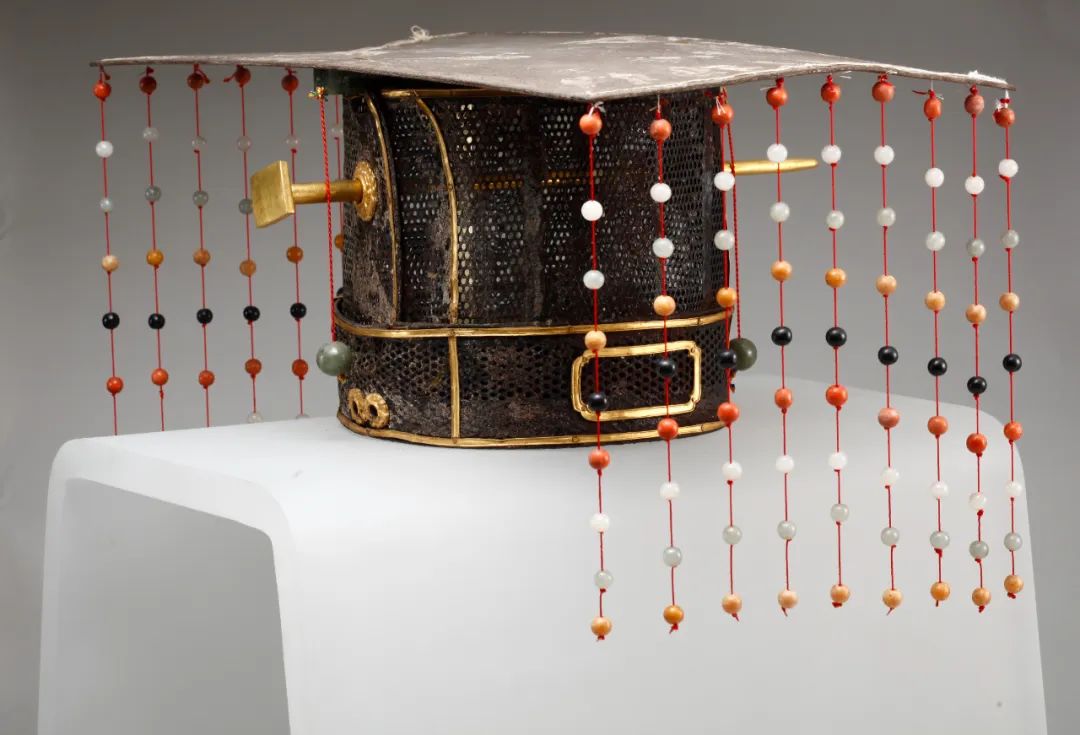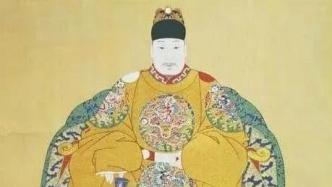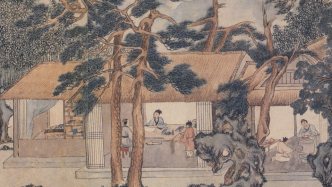
On January 12, "Treasures of Prince Lu - Collection from Zhu Tan's Tomb in the Ming Dynasty" was exhibited at the Shandong Museum. As one of the major exhibitions of Shandong Museum in 2025, the exhibition is planned from the perspective of "Life in the Royal Palace in the Early Ming Dynasty", and selects 682 pieces (sets) of cultural relics, covering gold, jade, clothing, lacquerware and other categories, including the nine-feathered crown, nine-seam leather hat, gem-inlaid gold belt ornaments, Tianfeng Haitao Qin and other exquisite cultural relics, one of the ten treasures of Shandong Museum. The number, scale and specifications of the exhibited cultural relics are unprecedented, vividly presenting the life of the princes in the early Ming Dynasty.
The nine-feathered crown on display is the only well-preserved crown from the early Ming Dynasty; the nine-stitched leather hat is the only extant leather hat from the early Ming Dynasty, filling the gap in the physical evidence of the Ming Dynasty's vassal system and providing an important reference for the study of ancient China's formal dress system.

The Ming Dynasty Nine-Tassel Crown "Treasure of the Prince of Lu - Collection of the Prince of Lu Huang" is on display

Exhibition site
It is reported that after two years of dormancy, the "Lu Wang Exhibition" has returned magnificently. The exhibition integrates the content according to the category of artifacts and is divided into five major sections: the prologue hall introduces the enfeoffment of the princes in the early Ming Dynasty and Zhu Tan's identity background. The first part is "Chengyun Fanping", which exhibits the etiquette content that shows the rank and status of the princes in the early Ming Dynasty, such as the crown, hat, and clothes, and the ceremonial guards of carriages and horses. The second part "An Rong Yang Zun" displays the daily necessities of the prince's mansion in the early Ming Dynasty, and shows the living conditions of the princes in the early Ming Dynasty from all directions and angles. The third part "Lu Fu Kui Bi" displays the piano, chess, calligraphy, and painting, as well as stationery unearthed from Zhu Tan's tomb. The tail hall introduces the basic situation of the tomb of Lu Huang Wang.
Among them, the cultural relics exhibited for the first time include the paper crown in the same shape as the nine-feather crown, the fruit core coral hat beads, the cross-collared short-sleeved yellow silk robe, the cross-collared narrow-sleeved yellow satin robe, etc., as well as the first complete exhibition of six wooden shawls (i.e. the ceremonial items that covered the coffin of King Luhuang). These cultural relics are of great significance for understanding the history of the Ming Dynasty and studying the social culture of the Ming Dynasty.

Exhibition site
Who is Zhu Tan, the Prince of Lu?
Zhu Tan was born in the third year of Hongwu in the Ming Dynasty (1370) and was the tenth son of Zhu Yuanzhang, the founding emperor of the Ming Dynasty. He was doted on since birth and was named Prince of Lu when he was only two months old, with his fief in Yanzhou. He loved poetry and books since he was young, and was good at poetry and songs. He should have been a prince with both virtue and talent, enjoying wealth and leading a happy life.
However, when he arrived at the feudal domain at the age of 15, he became obsessed with elixirs and poisoned himself after taking an overdose of elixirs. He bid farewell to this world at the age of 19, ending his short life. Zhu Tan's absurd behavior failed Zhu Yuanzhang's expectations and love. In order to warn future generations, Zhu Yuanzhang gave Zhu Tan the posthumous title of "Huang". Although Zhu Yuanzhang was very angry about his son's death from taking an overdose of elixirs, he still buried a large number of treasures with him.

Exhibition site
In the winter of 1969, villagers from Shangzhai Village, Zou County, Shandong Province, discovered a tomb passage while digging an air-raid shelter in Jiulong Mountain. It led to the tomb of Zhu Tan, the King of Luhuang in the Ming Dynasty. In 1971, the Shandong Provincial Museum hosted an archaeological excavation of Zhu Tan's tomb in Zou County, and unearthed 1,100 pieces (sets) of precious cultural relics, including crowns and hats, wooden figurines, furniture, stationery, chess, calligraphy and painting. Among them, the nine-feathered crown, the Tianfeng Haitao Qin, the gem-inlaid gold belt ornaments, and the red lacquer wooden box with gold-inlaid cloud dragon patterns are all unique treasures. These unearthed treasures were presented in the exhibition, and through the three units of "Chengyun Fanping", "Anju Wangfu" and "Lufu Kuibi", nearly 700 exhibits, the most authentic daily life of the princes of the Ming Dynasty was presented to the audience.
The exhibition hall draws on the architectural layout of "central axis symmetry" in ancient China. The five parts of the exhibition form a solemn, square, orderly and balanced organic whole, showing the majesty of the kingship. Han Minmin, a curator of the Collection Department of Shandong Museum, introduced that many of the cultural relics on display are the only ones in the country. "For example, the nine-feathered crown displayed on the central axis of the exhibition hall is the only well-preserved crown from the early Ming Dynasty." The nine-seam leather hat in the exhibition hall is "the only existing leather hat from the early Ming Dynasty, which fills the physical gap of the Ming Dynasty vassal system and also provides an important reference for the study of the ancient Chinese dress system."

Exhibition site "Nine-feathered Crown"
The "Nine-Tassel Crown" is the only complete crown found in ancient China. The crown was a ceremonial crown worn by ancient people when they worshiped the heaven and earth, ancestors, and held major ceremonies. The shape of the crown varied according to the status of the emperor. The distinguishing mark was the number of "tassels" hanging in front and behind the crown. Generally speaking, the emperor with the highest status had 12 tassels, the princes had 9 tassels, the senior officials had 7 tassels, and the junior officials had 5 tassels. Wang Wei, a poet of the Tang Dynasty, wrote in "An Early Visit to the Daming Palace with Jia Sheren" that "The nine-day gates of the palace are opened, and people from all over the world pay homage to the crown and tassels." The "crown and tassels" are a synonym for the emperor.
The nine-tassel crown unearthed from the tomb of King Luhuang is 18 cm high, 49.4 cm long and 30.9 cm wide. It is woven from bamboo strips, covered with silk and black lacquer, and inlaid with gold rings and gold edges. There are plum blossom gold piercings on both sides of the crown, and a gold hairpin is inserted. The top of the nine-tassel crown is a rectangular wooden board, called a "綖板". The 綖板 is round in front and square in the back, symbolizing the roundness of the sky and the squareness of the earth; it is low in front and high in the back, and it is in a forward-leaning posture, symbolizing that the emperor has the virtue of humility and can listen to the people's opinions. There are 9 tassels hanging in front and behind the 綖板, each with 9 jade beads, composed of 5 colors of red, white, green, yellow and black, which echoes the "Five Elements", meaning the unity of heaven and human relations, and the meaning of the emperor's connection with the universe. These 9 tassels hang in front of the king's eyes, blocking his sight, so that he does not look sideways and does not see things that are not right. "Seeing but not seeing" comes from this. There is a jade balance under the tassel plate, with a jade stone hanging from each end with a silk thread, which is called "Chong Er". The purpose is to remind the wearer not to believe in slander, which is the origin of "listen but not hear". Whether it is hanging tassels or plugging ears, the meaning is to warn the rulers to concentrate on governing the country and become wise rulers. However, the owner of the nine-tassel crown, Zhu Tan, the King of Luhuang, did not meet the expectations of the crown.
The exhibits also include the Tianfeng Haitao Qin unearthed from the tomb of Zhu Tan, the Prince of Lu, and made by Lei Wei of the Tang Dynasty. This Qin was made by Lei Wei, a famous Qin maker in the Tang Dynasty. As the only seven-stringed Qin in complete shape among the existing ancient Qins, Lei Wei's Shefu Qin was a treasure handed down from the Song and Ming dynasties, and caused a sensation across the country when it was unearthed in modern times.

Tianfeng Haitaoqin produced by Datang Leiwei

Exhibition site, Tianfeng Haitao piano
The red lacquer wooden box with inlaid gold dragon patterns is famous for its inlaid gold dragon patterns. During the Ming and Qing dynasties, the royal family was popular with inlaid gold lacquerware, and the inlaid gold technology reached its peak. This lacquerware unearthed from the tomb of Zhu Tan, the Prince of Lu in the Ming Dynasty, represents the highest level of inlaid gold technology in the Ming Dynasty. This cultural relic won this award because of its superb inlaid gold technology, which not only made the people of the Ming Dynasty feel noble and gorgeous, but also made contemporary people feel visually shocked.

Exhibition site, red lacquer wooden box with gold-inlaid cloud and dragon patterns
High-tech means to reproduce the "Golden and Green Landscape"
According to Lu Yuanliang, deputy director of the Cultural Relics Protection Department of Shandong Museum, during the curatorial and exhibition process of "Treasures of the King of Lu", the staff adhered to the concept of "cultural relics protection, prevention first", and each display cabinet in the exhibition hall was equipped with a constant humidity machine, "the restorer carried out a detailed pre-exhibition cleaning of each cultural relic, including the paper nine-feathered crown, paper belt and other funerary objects that have never been exhibited". Lu Yuanliang said that it is particularly worth mentioning that this exhibition shows the latest achievements of the cultural relics protection technology of Shandong Museum. The cultural relics protection staff re-depicted the "Golden Landscape Painting" unearthed from the tomb of King Lu Huang as the prototype and exhibited it to the audience in the form of a video.

Original painting of "Golden and Green Landscape"
"Golden Landscape" shows the latest achievements of Shandong Museum's cultural relics protection technology. The original painting was on silk, but the silk fell off later, leaving only the paper, with traces of silk in some parts of the painting. The colors of the painting have basically fallen off, leaving only traces of some outlines, from which you can see the shape of the mountains, trees and flowing water.

"Golden Landscape" MSI multi-spectral photography
The Shandong Museum's cultural heritage team observed through an ultra-depth microscope and found traces of gold in the lower left part of the painting. Using a portable X-ray fluorescence spectrometer, they found that the gold traces were metallic gold (Au), which reasonably inferred that the original painting used mud gold pigments. X-ray fluorescence analysis of the green stains in the painting found that the copper (Cu) content was high, much higher than the area without green stains. It was inferred that the green in this part was caused by blisters. The copper-containing pigment Shiqing is mainly made of azurite, with a chemical composition of 2CuCO₃·Cu(OH)2) and malachite (the main component is malachite, with a chemical formula of Cu₂(OH)₂CO₃). By performing MSI multi-spectral photography on the cultural relics, extracting the residual lines through tracing techniques, and analyzing its painting style, it can be basically inferred that it is a green landscape painting from the Song to Yuan dynasties.
Based on this, the cultural heritage protection team worked with professional painters to re-trace and color this landscape painting based on the extracted line drawings and color analysis results.

Coloring copy of "Golden and Green Landscape"
In addition to the exhibition, the museum has also developed more than 20 cultural and creative products in five categories of the "Treasures of King Lu" series, and the "Tracing Back to the Elegant Style and Charm of the Ming Dynasty, and Exhibiting the Glorious Etiquette of the Ming Dynasty" research and study educational activities will also be launched in succession.
Note: This article is compiled from Shandong Museum, "New Yellow River" and other sources.

